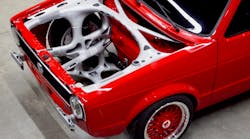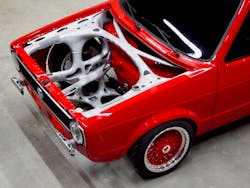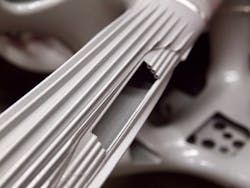3D printing is helping the aerospace industry miniaturize and create lightweight parts. It also helps save time with fixtures and jigs in the automotive industry. However, none of these applications are designed for safety. You wouldn’t expect someone to 3D-print a part with a collision in mind. However, as designers become more creative and knowledgeable with 3D printing, this process burrows deeper into the automotive industry.
3i-PRINT is a new partnership project that highlights the potential of industrial 3D printing. A recent report from Global Newswire notes that Altair, APWORKS, csi entwicklungstechnik, EOS GmbH, GERG, and Heraeus have used the front-end structure of a classic Volkswagen VW Caddy to demonstrate the full potential of organic load-bearing structures within the automotive industry. Taking advantage of 3D printing’s fast iteration and ability to manufacture complex geometries, the build took nine months and incorporated multiple parts into a single build.
A 3d-printed front-end structure of a classic Volkswagen VW Caddy was used to demonstrate the full potential of organic load-bearing structures within the automotive industry
This is not the first time a car company used 3D printing. Ford has been 3D printing for over 20 years now. However, the company only relatively recently explored using 3D printing for end-use parts. Ford was experimenting with gaskets and small parts; this new project digs even further into the adaptation the automotive industry will have to make as regulations and market segments want to see more efficient cars on the road.
If you think in the traditional way of design parts, it is hard for 3D printing to compete with traditional processes. The value is integrating multiple pieces into one. For example, when the Oak Ridge National Laboratory printed a backhoe arm, it was able to build channels into the load-bearing parts for the hydraulics. This eliminated the hoes and connectors, and increased the value of the arm to better compete with traditional processes. This works the same way in the automotive industry.
While the growth of electric vehicles finding lightweight yet high-performance solutions is important. The structural front end of the VW Caddy included passive cooling. Air channels were designed to cool batteries and braking systems. In addition, safety features, fluid storage, and functions linked to heat management are all built into the 3D-printed front end.
With these goals in mind, the experts at csi entwicklungstechnik began designing, developing, and building the front-end structure. The company develops high-quality modules for vehicle bodies, interiors, and exteriors for both manufacturers and suppliers in the automotive sector. GERG is a leading supplier of innovative solutions in the area of prototyping and small-scale series for the automotive and aerospace industries. In this project, GERG was responsible for connecting the additively manufactured components and the creation of the final frame. With their focus on the development and broad application of simulation technology to synthesize and optimize designs and processes, Altair's software solutions were used to design, optimize, simulate, and develop the structure.
The cutout shows the design functional integration of thermal management inside the load bearing structure.
The 3i-Print project is open source for fast development through a community. Among other events, the Caddy can be viewed at the Converge 2017 in Essen and the formnext 2017 in Frankfurt. For more information, visit www.3i-print.com.



